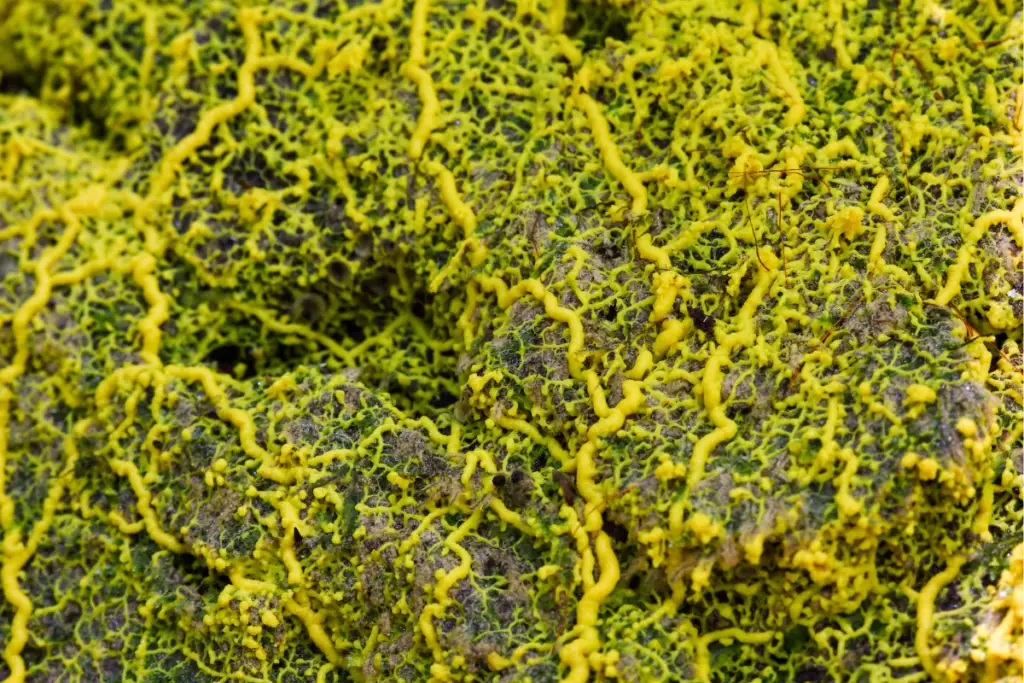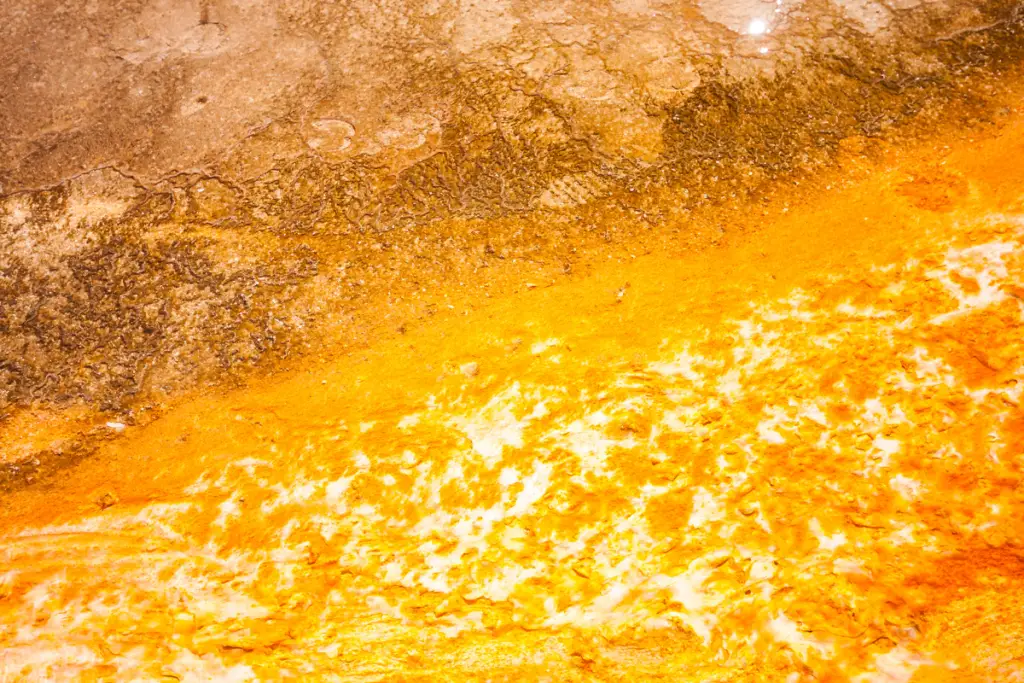Yellow or orange particles in a humidifier are caused by mold or mineral deposits. Mold, such as Aspergillus flavus, Epicoccum nigrum, or Geomyces pannorum, grow in humidifiers that are not cleaned often enough. Whereas, mineral build-up occurs when tap water (especially hard water) is used instead of distilled or purified water.
Many of us use humidifiers to make the air easier to breathe. But after using one for a while a yellow substance can appear on the inside of the unit or around the water nozzle and it’s important that we stop running it.
This guide explains what causes the yellowish-orange substance in your humidifier, how to figure out which problem you have and importantly, how to fix it and stop it from happening in the future.
What the blazes is the yellow substance in your humidifier
Mold

Yellow mold is the most common cause of a yellow or orangish growth in your humidifier. Mold is a fungus made of tiny organisms that love wet conditions.
There are several types of yellow mold, including:
- Acremonium strictum
- Aspergillus flavus
- Epicoccum nigrum
- Geomyces Pannorum.
- Mucor
- Others include Dry rot, Fungus, and Serpula lacrymans.
Mold grows in wet and enclosed areas. Because a humidifier is an enclosed tank, it acts as a perfect home for mold growth.
These types of mold are particularly common in humidifiers that are not cleaned or maintained regularly.
In fact, when the the inside of a humidifier isn’t cleaned often enough the mold first establishes then multiplies.
As the mold multiplies in the humidifier, it travels into the air around the house, potentially causing some health problems.
These health conditions include humidifier lung, a rare health condition that happens when you breathe in contaminated air from ventilation units, like a humidifier.
Other mold-contaminated symptoms include chills, coughing, fever, shortness of breath, and lung inflammation.
How to know if you have yellow mold in your humidifier
- Look inside your humidifier’s reservoir for any yellow or orange discoloration.
- Check your humidifier for a musty odor.
- If you left water in the reservoir during the previous usage, look for a yellow or orange layer that indicates mold.
- Check to see whether you or anyone in your family has respiratory allergies or lungs that are inflamed.
- Look for itchy skin rashes and itchy eyes, which can indicate a response to mold.
How to remove mold (yellow stuff) from your humidifier
To fix a mold problem in your humidifier, you’ll need to clean it.
Cleaning a humidifier is simple and inexpensive. It’s also the most recommended and preferred way to get rid of mold in your humidifier. There are two regular household items you can use to fix a mold problem in your humidifier:
- Vinegar.
- Hydrogen peroxide.
Using vinegar:
- Unplug the humidifier from the power supply.
- Empty its reservoir.
- Pour one cup of white vinegar into the humidifier’s reservoir and scrub it using a bristle brush.
- Fill the humidifier’s base with 1 cup water and 1 cup white vinegar and set it aside for an hour.
- To effectively agitate any grime, shake and swish the humidifier for 5 to 10 minutes.
- Scrub with a brush after the solution has sat for an hour, and drain the solution.
- Wipe the outside of the humidifier with a moist towel
- Once emptied, refill the reservoir with plain hot water then rinse any loose material from the reservoir and nozzle several times.
- Allow it to completely dry before using it.
Using bleach:
- Unplug the humidifier from the power supply.
- Empty its reservoir.
- Create a bleach solution, using half a cup chlorine bleach with two cups of water
- Add the bleach solution to the humidifier’s reservoir and set it aside for 15 minutes.
- Connect the device to an outside outlet. Set your humidifier to run for 30 minutes outside. This will allow the bleach solution to reach all parts of the humidifier, including those that were difficult to reach with a scrub brush.
- Drain the bleach solution from the reservoir and thoroughly rinse it under running water. To flush away any bleach residue, fill the reservoir with clean water and run it for three minutes.
- After you are finished, wipe the outside of your humidifier with a damp cloth and let it dry thoroughly before using it again.
Mineral deposits

Mineral deposits are a common reason for a yellow or orange substance in a humidifier. Minerals build-up when hard water, usually from tap water, is used in the humidifier.
The minerals in hard water (like calcium and magnesium) are left behind in the humidifier as the water evaporates away. These minerals then combine with dust or dirt and hardens on the heating element as a yellow/orange substance.
Your humidifier will be especially prone to mineral build-up if old water sits inside the reservoir, if you don’t clean your humidifier regularly, or when you use tap water instead of distilled water in your humidifier.
How to know if you have yellow mineral build-up in your humidifier
- Check your humidifier for a foul odor while operating.
- Look for a hardened yellowish deposit.
- Cloudy water tank.
- A white dust is emitted from the humidifier, and settles around it.
Note: Check if your water is hard, as hard water is the leading cause of mineral build-up. If you can’t test the water hardness, look for basic signals like soap scums and foggy utensils.
How to remove mineral build-up (yellow stuff) from your humidifier
- Unplug the humidifier from the power supply.
- Empty its reservoir.
- Fill the reservoir with undiluted vinegar solution.
- Let it soak for at least 4 hours
- Drain the solution.
- Rinse the humidifier reservoir with warm water.
- Treat any visible mineral deposits with undiluted vinegar by dipping a soft cloth in white vinegar and then applying the cloth to the affected area.
- Rub vigorously until the scale is entirely dissolved, then rinse it with warm water several times.
- When through, wipe the outer part of the humidifier with a damp cloth.
- Let the humidifier completely dry before using it again.
If your humidifier has a filter and has some noticeable mineral build-up you’ll need to throw it out and replace it with a new filter.
How to prevent yellow mold or mineral build-up in your humidifier
1. Regular cleaning
Cleaning your humidifier regularly is the first step in taking care of it. Filters and reservoirs that are dirty help mold, germs, and bacteria grow by providing a host environment. If you can, change the water every day and clean your humidifier twice a week (weekly as a minimum).
Mold and mineral build-up will not grow in a humidifier that is kept clean.
2. Use vinegar
Use vinegar when cleaning your humidifier. Vinegar is a powerful cleaning agent that can be used to eliminate mold and mold spores. It is antibacterial and antimicrobial, and will keep spores from growing in the tank for a long time.
In fact, vinegar is better at removing mold spores than bleach.
3. Empty the water reservoir
Don’t leave water in the reservoir of your humidifier.
Mineral build-up in particular, happens when water stays inside the reservoir when the humidifier isn’t being used. It also promotes mold and bacteria growth, which can spread throughout the humidifier.
After you have finished using your humidifier, make sure to empty the reservoir (and clean it out if you have the time).
4. Always use distilled water
Tap water is often mineral-rich hard water that helps create mineral deposits. Whereas, distilled water is purified to remove dissolved minerals and other contaminants, making it less likely to cause deposits inside your humidifier.
As a result, distilled water should be used instead of tap water in your humidifier – as recommended by most manufacturers.
5. Adjust the humidity level
Mold can thrive in any environment with a humidity level greater than 55%. We use our humidifiers at greater humidity levels for various reasons, but little do we realize that high humidity encourages mold growth in the humidifier and even in our houses.
So, if you want to avoid mold, set your humidifier to a lower humidity setting (30 to 50% is ideal)
6. Follow the manufacturers instructions
There’s a reason why home appliances come with a user manual. If you are unsure about something, always consult it. If you’ve lost your user manual most brands have a digital copy available on their website.
Frequently Asked Questions
How to know if your humidifier has mold?
Mold in a humidifier can be identified by any discoloration in the tank or by the presence of a film on the water. Moldy humidifiers will often smell musty when running. Any family members suddenly suffering from respiratory allergies or irritated lungs can also indicate mold has established in a humidifier.
Itchy skin rashes and itchy eyes can also be caused by a mold or mildew allergy brought on by a humidifier.
Look for mold growths in your humidifier if you’re having problems breathing.
Can you get sick from a humidifier?
Breathing air from a contaminated humidifier can cause illness in healthy people. Humidifiers propel and disperse particles, including microorganisms and minerals, into the air. Breathing this air can lead to inflammation of the lungs and a rare health condition known as ‘humidifier lung’. However, humidifiers that are regularly cleaned and maintained do not pose a health risk, given the available data.
Dirt, mold, germs, and mineral build-up in the humidifiers cause these illnesses. Clean your humidifier regularly, empty the reservoir after each use, make sure the humidifier is totally dry before using it, check your humidifier frequently, and, most importantly, use it on the lower humidity to discourage mold growth.
Plentiful Air has more information the links between humidifiers and illness available here.
